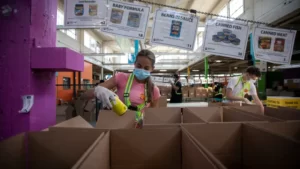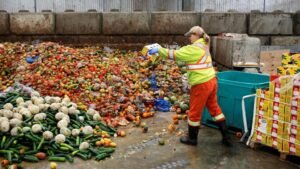Food insecurity is a global issue with widespread impacts, affecting both individuals, communities and entire regions. It is defined as a lack of consistent access to enough food for every person in a household to live an active, healthy life. Almost 12% of the global population (928 million people!) was severely food insecure in 2020. So, when we also hear statistics such as “a third of all food goes to waste”, we cannot help but feel angry.
This led to the creation of several campaigns fighting food waste. From awareness campaigns telling us to buy produce that looks bad to apps which allow consumers to buy products close to their expiration date for discounted prices, everyone is trying to do their part. But is household-level food waste the real problem, or a symptom of wider issues? Let’s explore the history of reputation laundering, look at the similar case of plastic straws and explore true solutions to food insecurity.
Reputation laundering
There is more to food waste than it seems. To understand the recent surge in attention given to the issue, we must understand the concept of reputation laundering. In the simplest terms, it refers to unethical people or organizations doing highly visible positive acts to improve their reputation and obscure their history. This can take an almost limitless variety of forms and be made to appeal to a variety of groups. From certain video game developers posting statements in support of BLM to garner public support while having a very little representation of people of color, to supermarkets which have donation baskets but raise their prices to unaffordable levels, there are countless ways to try to pander to people’s desire for a better world.
A particularly relevant form of reputation laundering is greenwashing, the practice through which something is made to seem environmentally friendly when it’s actually harmful. While it has been coined in 1986, it has become significantly more widespread recently due to the raising concerns about climate change and has provided us with truly ridiculous examples such as British Petroleum making their logo green.

Source: @STARBUCKS
The plastic straw
Haunting images of turtles choking on straws were used to raise awareness all over the world, and people were told to reduce their own plastic waste and participate in beach clean ups. Ample campaigns made many fast-food chains change their plastic straws for paper ones while loudly declaring their commitment to the environment. But does this address the cause of the issue?
While it’s true that marine plastics are endangering all ocean life and polluting coasts all over the globe, individual consumers play a much smaller role than they were led to believe. Two thirds of all ocean plastic is made up of discarded fishing gear, and the single biggest source of plastic pollution is represented by fishing nets. These fishing nets are designed to capture and kill, and are often considered the cause of mass drownings, such as when 300 turtles were found dead off the coast of Mexico.
The image becomes even clearer when you consider the sources of ocean plastic pollution. Europe and North America make up a combined 5% of plastic waste emitted to the ocean, so their consumers are hardly to blame for this. What did these campaigns against plastic straws achieve? They let plastic producers and the fishing industry off the hook and prevent meaningful, systemic change from being considered while also increasing sales for companies and lowering public scrutiny. While people minimizing their plastic use and participating in beach cleanups has a variety of environmental and social advantages, the idea that banning plastic straws was a monumental environmentalist victory against a deeply rooted evil is a cynical greenwashing spectacle using people’s support for the environment against them.

SOURCE: @Sean A. Williamson.
The causes of food insecurity
The causes for food insecurity are extremely variable. Sometimes, food is simply not available for entire regions due to unusual circumstances such as extreme weather events or wars. Other times, food is technically available, but people cannot afford it for reasons such as poverty, unemployment, or low income. Factors which exacerbate the risk of food insecurity include lack of affordable housing, chronic health conditions or lack of access to healthcare. Generally, richer countries have less issues with poor security and poorer ones more, but no country has fully eradicated it.
Despite the frequently used image of the “starving third-world child” used by countless charities, food insecurity plagues developing and developed countries alike, affecting people of all nationalities and ages. A 2017 UNICEF report found that one in five children in the UK suffers from food insecurity, with millions relying on free school meals. The problem was worsened by the COVID pandemic, with some food banks reporting that demand has doubled, and since August 2020, UNICEF is funding charities to feed hungry children in the UK for the first time in history. In the United States, 13.8 million people were considered to not have food security. According to the 2019 Eurostat, 11.3% and, therefore, almost 58 million people in Europe cannot afford a protein meal every two days, making them susceptible to hunger and malnutrition.
It becomes clear that very often, the cause of food insecurity is not just a lack of food, but lack of access. Inequality makes people go to bed hungry while living next to supermarkets. Our economic system drives farmers to destroy their own crops while entire countries face famines. As isolated individuals, our food habits cannot change that. Food waste would be to blame for food insecurity if there were global food shortages, yet we produce significantly more than enough to feed everyone, at least in theory.

SOURCE: @CBCNEWS
Breaking down food waste and food loss – how much is the consumer’s fault?
The most basic definition of food waste is food that goes uneaten. It has a variety of harmful effects: CO2 emissions, increased land use, and water waste among others. And if you use social media or watch the news, you’re likely to think that it’s behind the rampant food insecurity many countries are facing, and that it is caused mostly by people who buy food and then throw it away. Countless infographics inform consumers on tips for preventing food waste, such as buying wonky-looking veggies or organizing their fridge so that items nearing their expiration date are near the front. Food waste and food loss, however, are a lot more complex than you might believe. They occur during production, processing, distribution, retail and food service sales, and consumption.
One analysis estimated that global food waste represented 931 million tons, equivalent to 120kg per capita. It was split across three sectors: 61 per cent from households, 26 per cent from food service and 13 per cent from retail. This points the finger at consumers as the main group responsible. However, this analysis excludes food lost during production and transportation– and a significant proportion of food is lost before meeting consumers.
Let’s use the United States as a case study. In the US alone, 20 billion pounds of food are lost on farms, out of a total of 125 to 160 billion pounds of wasted food. Some losses are caused by pests and droughts, while others happen because of purely economic reasons. If the price of products on the market is lower than the cost required to harvest and transport it, farmers will engage in dumping. For example, during the COVID pandemic, due to restaurant and school lunchroom closures, farmers were unable to sell their products and decided to plow over edible crops and dump up to 3.7 million liters of milk per day onto fields. There is a similar problem on fishing boats, with an estimated 8% of all caught marine life discarded dead or dying. Labor shortages can lead to entire harvests being left to rot on the field.
Loses during transportation, packing and manufacturing are harder to assess, but their causes include overproduction by farmers, product damage, technical issues and discarding produce for aesthetic reasons. During the COVID pandemic, tens of thousands of animals were slaughtered and discarded without being processed because the workers were sick. Perishable food shipments are sometimes rejected by the buyer, and if a new buyer cannot be found it must be thrown out.
Within retail, many practices considered good business strategies have negative impacts on both food waste and food security. Overstocked product displays, expectation of cosmetic perfection of fruits, vegetables and other foods, oversized packages, the availability of prepared food until closing: all these factors not only lead to waste, but also encourage shoppers into overconsumption. Food safety regulations can also drive retailers to dispose of food that could no longer be safe, such as during floods and power outages.
In restaurants and other food service facilities, oversized portions, inflexibility of chain store management, over-preparation of food, improper ingredient storage, failure to use food scraps and trimmings, and extensive menu choices are some of the drivers of food waste. All-you-can-eat buffets are particularly wasteful, as all food not eaten must be discarded.

SOURCE: @OLIO
What drives wasteful household behavior?
Lastly, while it’s undeniably true that households generate significant food waste, we need to look at this more closely. Nobody wants to throw away food they paid for, so what mechanisms drive this? Several strategies are employed by both retailers and restaurants to drive consumers to buy more than they need.
When shopping at a supermarket, a lot of products are cheapest when bought in large quantities, creating a perverse incentive to overbuy. Others are only sold in quantities larger than what the customer will need. People who are buried beneath their day jobs or live very far away from supermarkets might decide to buy in excess, preferring to throw away some food rather than make a one-hour trip to a discount supermarket to get one carton of milk or one banana. People who live alone might struggle with the large portion sizes sold while also trying to have a varied diet, while large families might be unable to estimate how much food they need and prefer to overbuy.
Meanwhile, many restaurants boast huge portions with many sides to justify their high prices. Delivery apps constantly give people promotions on a random basis, making the convenience and low price of ordering food much more attractive than cooking at home, even if the fridge is full. Many people are struggling with stress, mental health, and time management and might decide to order takeaway because they do not have the energy to prepare a meal, even while aware that some food items in their fridge will go bad soon.
Another significant aspect is confusion surrounding expiration dates. Terms such as “use by”, “sell by”, “best before” can be mixed up with the products expiration date, which has significant effects: up to 80% of consumers discard food prematurely due to data label confusion. Making clear guidelines on what these dates mean and communicating this to people has a high potential to reduce household food waste.
Consumerist culture itself plays a big role in shaping our values regarding food waste. We see ads with happy families and a fridge so full it can barely close, or with groups of friends eating almost grotesque servings of fast food while laughing and having fun. We associate our wealth and wellbeing with the image of a full fridge, not one that has just what we plan to cook for our next few meals. We associate huge portions with good value and ignore the hidden environmental costs.
So, while it might be you throwing away a carton of eggs because they went bad, it’s an entire economic system with multiple industries behind it that overproduced them, sold them at a discounted price and said you need to buy now or you’re missing out through gigantic advertisements.

SOURCE: @Andrew Spear for The New York Times
Addressing the root causes
Fighting food waste at the personal level is a great way to save money and build a healthy relationship with food. It can help you get better at managing household finances, pay closer attention to what you eat and improve your cooking skills. But just like saying no when offered a plastic straw cannot stop the fishing industry, wrapping your strawberries in paper towels so they last a few days longer cannot fight food insecurity or reduce the environmental damage of agriculture.
What is needed is widespread, policy-changing action. A new model of resilient and sustainable agriculture. Interpersonal care and international solidarity. Jobs which don’t overwork and underpay people. A culture where moderation and satisfaction are more treasured than endless consumption. A reimagined economy where it’s not a good business strategy to let children go to bed hungry. You can only change your own behavior, but we can change our society.
We need to stop thinking about the single turtle choking on a plastic straw and start seeing the oceans filled with deadly nets. We need to stop caring only about little acts of reducing food waste while allowing big corporations to brag about reducing the food waste they themselves created. We need to stop thinking of ourselves as isolated individuals in our own little bubbles and work together to build the world we want.
DISCOVER WISEFINS